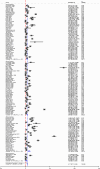Prevalence, trends, and distribution of hepatitis C virus among the general population in sub-Saharan Africa: A systematic review and meta-analysis
- PMID: 39268900
- PMCID: PMC11586889
- DOI: 10.1111/liv.16102
Prevalence, trends, and distribution of hepatitis C virus among the general population in sub-Saharan Africa: A systematic review and meta-analysis
Abstract
Background and aims: Although the evidence is uncertain, existing estimates for hepatitis C virus (HCV) in sub-Saharan Africa (SSA) indicate a high burden. We estimated HCV seroprevalence and viraemic prevalence among the general population in SSA.
Methods: We searched Medline, Embase, Web of Science, APA PsycINFO, and World Health Organization Africa Index Medicus for community-based studies. Study quality was assessed using the Joanna Briggs Institute critical appraisal tool, and heterogeneity using the index of heterogeneity (I2). Two approaches were deployed. First, we used random-effects meta-analysis to pool prevalence. Second, to derive representative estimates, we weighted each country's HCV seroprevalence using 2021 United Nations country population sizes.
Results: We synthesized 130 studies. Overall, SSA HCV seroprevalence from the random-effects model was 4.17% (95% confidence interval [CI]: 3.71-4.66, I2 = 99.30%). There were no differences between males (4.31%) and females (4.03%). Seroprevalence was 2.25%, 3.31%, and 16.23% for ages ≤20, 21-64, and ≥65 years, respectively, and was higher in rural (6.63%) versus urban (2.93%). There was indication of decrement overtime from 5.74% to 4.35% to 3.03% in the years 1984-2000, 2001-2014, and 2015-2023, respectively. The weighted overall SSA HCV seroprevalence was estimated to be 2.30% (95% CI: 1.59-3.00) with regional variation: Africa-Southern (.79%), Africa-Central (1.47%), Africa-Eastern (2.71%), and Africa-Western (2.88%). HCV viremia among HCV seropositives was 54.77% (95% CI: 47.80-61.66).
Conclusions: HCV seroprevalence in SSA remains high. Populations aged ≥65 years, rural communities, Africa-Western, and some countries in Africa-Central and Africa-Eastern appear disproportionately affected. These results underline the need for governmental commitment to achieve the 2030 global HCV elimination targets.
Keywords: HCV; SSA; general population; seroprevalence; viraemic prevalence.
© 2024 The Author(s). Liver International published by John Wiley & Sons Ltd.
Conflict of interest statement
The authors do not have any disclosures to report.
Figures




References
-
- Spearman CW, Sonderup MW. Health disparities in liver disease in sub‐Saharan Africa. Liver Int. 2015;35(9):2063‐2071. - PubMed
-
- Global Progress Report on HIV, Viral Hepatitis and Sexually Transmitted Infections, 2021. Accountability for the Global Health Sector Strategies 2016–2021: Actions for Impact. World Health Organization; 2021.
-
- Polaris Observatory HCV Collaborators . Global change in hepatitis C virus prevalence and cascade of care between 2015 and 2020: a modelling study. Lancet Gastroenterol Hepatol. 2022;7(5):396‐415. - PubMed
Publication types
MeSH terms
Grants and funding
LinkOut - more resources
Full Text Sources
Medical
Research Materials

